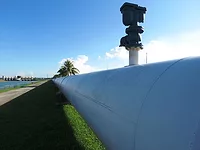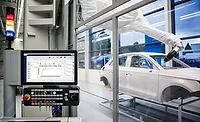A New Breed of Paint Shop Intelligence
The Eaton Inoac plant in the northern Ohio town of Fremont is an automotive Class A trim supplier. The company's two paint lines use more than 250 different colors to supply components for about 35 car models. To better manage the extensive painting operations, Eaton Inoac installed a manufacturing intelligence system that has helped it boost productivity and cut costs.
The company blow molds and paints various trim pieces, including spoilers, ground-effects packages, wind deflectors, body side moldings and mudguards for nearly every major auto manufacturer with operations in the United States. With a special emphasis on spoilers, the company's 400 employees annually produce 750,000 to 850,000 of them-about 70% of the spoilers produced in North America.
In late 2000, Ritchie Automation started automating one of the paint lines with electrostatic hand sprayers, reciprocators and rotary atomizers (bells). Robots were added in late 2002. At that same time, Eaton embraced a new concept in paint shop management called Paint Shop Manufacturing Intelligence (PSMI).
Ritchie Automation had already been working on a Manufacturing Intelligence (MI) solution specifically designed for the paint shop for several years, so the timing was right. Ritchie's Paint Keeper program had been implemented in some other painting facilities, so it became the final component added to the new automated paint line.

Data in context
The goal of Paint Keeper and other PSMI solutions is to transparently collect valuable process data from throughout the paint line and put it into the proper context. This information is then stored and used for building historical and timeline trends. These systems analyze those trends and other data, and then everything is reported in real time to the plant's management, supervisors and workers for making better decisions.Although millions of dollars were spent over the last two decades on complex ERP systems with the hope that they would provide this type of information, that wish never fully materialized (see sidebar). ERP systems have primarily become sophisticated accounting programs and the important work-in-progress (WIP) data has been virtually ignored, especially in the paint shop. MI and PSMI systems fill that void of missing information.
When properly integrated, they allow ERP systems, as well as initiatives like lean manufacturing and six sigma, to perform at their peak effectiveness. Ultimately, these systems play a major role in increasing a plant's productivity and profits. Several MI solutions are now available for general manufacturing processes, but Paint Keeper is the only MI solution designed specifically for the paint shop.
PSMI can be viewed as a module of the company-wide MI system. But since the paint shop is such a different type of manufacturing operation, it requires a purpose-built MI system that considers the critical factors unique to the painting industry and, most importantly, to the paint shop management team.

• Automatic data collection from application and inspection systems
• Monitoring and reporting of VOC emissions and processes
• Calculating real-time costs (of work in progress)
• Measuring production performance
• Controlling "process creep" (the small adjustments made over time that take a system away from optimal performance and/or create an overuse of paint)
• Analyzing and managing paint usage, mixes and inventory
• Tracking hazardous chemicals
• Downtime monitoring and analysis
Mike Strausbaugh, the paint engineering manager, and Chuck Kotsilidis, the paint/process engineer, led the PSMI effort for Eaton, which had the support of everyone from the plant manager to the line workers. Strausbaugh and Kotsilidis are thrilled with the positive impact Ritchie Automation's Paint Keeper system has already had on their plant, yet they feel they are only seeing the tip of the iceberg for what the system will eventually do for them.

No more clipboards
Many of Paint Keeper's benefits are due to its ability to accurately track paint mixes and their usage throughout the system, as well as to maintain the historical integrity of paint mixes over time. Prior to installing Paint Keeper, Eaton performed this tracking task similar to most painting operations, with manual notation on clipboards, followed by manual input into various database files.This was a very labor-intensive, and error-prone process that generated multiple databases, each designed for a specific purpose. These "islands of data" that were created could not identify larger, more complex problems that required linking several pieces of data together to be revealed, nor could they easily generate historical trends or present real-time data. In addition, like any manual data-tracking process, Eaton's system presented many opportunities for errors, from typos to omissions.
Accurately tracking paint mixes and their usage is critical for a painting operation to become as efficient, productive and profitable as possible. EPA reporting, transfer efficiencies, inventory maintenance, quoting and more is either positively or negatively affected by this tracking process.
In the area of EPA compliance and reporting, Paint Keeper ensures 100% compliance, and reports are generated at the touch of a button, at any time. Even with EPA rule 66, which is a state-by-state law addressing the complex subject of photo-chemically reactive materials (PCRMs), Paint Keeper keeps Eaton compliant by not allowing paint mixes to be used if they don't pass the PCRM test.
"Tracking PCRMs is a difficult task," says Shawn Reinhart, Eaton's environmental manager. "Most companies don't even know if they are running PCRM paints. But most likely, they will have to be compliant in this area in the future. Paint Keeper makes this, as well as VOC emissions and other compliance, easy."
Most of Eaton's EPA reports are handled by Paint Keeper, and Reinhart is certain that it will eventually handle all of the company's reports. Streamlining and simplifying the EPA tracking processes has allowed Eaton to reassign two clerks and two engineers to other projects and to reduce the role of an outside environmental engineering consulting firm. In addition, reports can now be generated daily instead of monthly, as they had been in the past.

Tracking paint usage
Accurately tracking paint usage is another area where Paint Keeper excels. The system allows painting operations to identify, in many cases for the first time, the exact amount of paint being used and the exact transfer efficiency being realized at every point throughout the paint line. Gaining this knowledge helped Eaton in numerous ways, starting with paint inventories.
As most companies see it, it is better to err on the side of caution and stock more paint than they need, rather than not enough. However, stocking paint that isn't truly needed can tie up millions of dollars in inventory and can create excess waste since paint has a relatively short shelf life. With the accurate usage tracking provided by the system, Eaton has been able to dramatically reduce its inventory, recapturing more than $14,000 in just four months.

Eaton's new project quotes are much more competitive because they know exactly what the painting will cost. Like other painting operations, Eaton had lost orders in the past because its estimates were too high, and they had lost money on projects because their estimates were too low. Eaton no longer has to play this industry-accepted guessing game.
Since Eaton now knows exactly what it costs to paint any given part, its scrap and rework estimates are also much more exact, and this has had a dramatic and unexpected impact on the company's bottom line. Since paint usage was typically being estimated as higher than it actually was, scrapped and reworked parts estimates showed up in accounting as higher losses than they actually were.
Knowing the exact cost of painting each part allowed Eaton to decrease the losses being estimated, thus positively affecting the profit margin of the plant. This change is recapturing approximately $5,000 to $10,000 per month for the bottom line.
Knowing exact usage also helps a company maximize its production capabilities. If a plant is overestimating its paint usage, then it's unnecessarily reducing the amount of production it can handle.
Booting the creep
Paint Keeper has also helped Eaton control process creep. Since paint line operators rarely get in trouble for using too much paint, as opposed to not using enough, the adjustments made typically create an overuse of paint. By closely monitoring every aspect of the paint line, Paint Keeper helps to keep the system at its optimal performance settings, while maximizing the system's transfer efficiencies.
Overuse of paint costs painting operations millions of dollars each year. If a part that is specified to have 1 mil of paint receives 1.2 mils, then 20% more paint is used than is necessary. This type of excess paint usage is extremely common in the painting industry. Through Eaton's various changes to its new automated paint line, transfer efficiency has been increased by 25% for basecoats and clearcoats. A portion of this paint savings is directly attributed to Paint Keeper, without which Eaton wouldn't know exactly what this savings was (there would be no way to measure it).

This allows the company to operate more lean. Since installing Paint Keeper, Eaton has been able to eliminate Saturday production. An exact cost savings hasn't been calculated for this change, but considering the time-and-a-half rate for labor, the additional energy costs, the costs of rescheduling cleaning and maintenance personnel to Sunday (at double time), it is substantial.
Eaton's next goal is to place all of its paint shop management data in one place. It will add Paint Keeper's companion program, Paint Stats, to address the inspection and quality issues of its operation. Afterward, the company plans to update its second paint line, as well as extend this technology to its other plants.

Sidebar
Avoiding Manufacturing's Black Hole
For decades, companies throughout the world have been implementing initiatives to increase productivity, quality and profits, while decreasing waste and excess spending. Initiatives like lean manufacturing, Six Sigma and continuous improvement have become common terms in manufacturing companies. But for these initiatives to be most successful, they require continuous and real-time data to be supplied from all areas of the supply chain and the production processes. Unfortunately, the capture and use of this data-any information that allows a company to make better decisions, improve quality and increase profits-is typically the weak link in the process.
In theory, this critical data would be supplied by the ERP system. In practice, these elaborate ERP systems have primarily become the tools of the CFO, focusing more on the raw materials flowing in and the finished goods flowing out (i.e., the cash flow elements). In the end, most ERP systems look like very expensive and elaborate "accounting systems" and the work in progress (WIP), where the most important data should be found, is virtually ignored.
This "black hole of manufacturing" can be found in most plants throughout the world. It exists at the center of the organization, with an ERP system orbiting all around it. No data can escape this black hole of manufacturing, at least not intact or in the proper context. Without this data, the ERP system, lean manufacturing and other improvement efforts will never reach their ultimate level of success, and productivity and profits will never be fully maximized.
So what's the problem? Why can't the important WIP data escape from the black hole of manufacturing in a usable and valuable form?
The simple answer is that this task has traditionally been too complicated. Within the multitude of systems and processes in the manufacturing area of a business, there may be thousands of I/O devices, sensors, meters and alarms, and the data from these devices are being fed into various automation control panels, CPUs and PLCs.
Each of these systems interpret data in the manner that is appropriate for its specific process or need, and "completely independent" of the other systems in the plant. Before this data can be converted into useful information, it must be compiled into one place, and brought into the proper "context."
But that is where the real problem lies. Tying all of these diverse systems together, getting them to use the same nomenclature, and possibly changing the culture of the plant so that it embraces the new processes can be a daunting task.
So what's wrong with multiple systems? The data doesn't exist in the proper context. Each department, work cell, individual machine and their respective managers have their own way of analyzing and using the data they collect (assuming they collect it in the first place).
One manager may use Excel spreadsheets, another uses Access databases, and yet another manager uses a custom program he had the IT department develop (see diagram). Each manager is looking for specific data and metrics that affect the perceived success of a particular area and, if necessary, they will tweak that data to make sure their story is a good one.
As an example of the problems created by data that's out of context, look at a typical paint shop. The managers of a paint shop know how much paint and solvent they buy and use, how many parts they have painted and how many different types of parts they process, but they generally don't know how much it costs to actually paint a specific part.
With all that data in their hands, estimating a project is still just an educated guess. Multiple data-collection systems and out-of-context data doesn't allow exact costs, correlations, trends and other important decision-making data to be identified.
A manufacturing intelligence system corrects this situation by transparently collecting manufacturing process data from multiple sources, putting it into the proper context, storing it for building historical and timeline trends, analyzing it, and reporting it in real-time to the plant's management, supervisors and workers for making better decisions. MI systems ultimately increase the plant's productivity and profits, while allowing ERP systems and manufacturing initiatives like Six Sigma to perform at peak effectiveness. MI systems also allow critical knowledge to be easily shared across multiple plants to duplicate efficient processes and gain company-wide efficiencies.
Looking for a reprint of this article?
From high-res PDFs to custom plaques, order your copy today!








